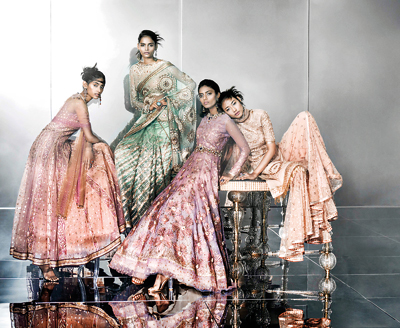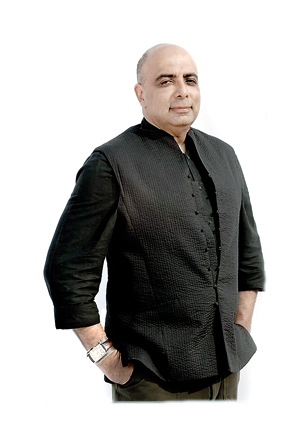Taking Indian fashion to the world away from the cliche

Dramatic, elegant and voluminous: Tarun Tahiliani’s designs for the modern Indian woman
Rich glittery bridals and vibrant Indian embroidery against Western silhouettes are Tarun Tahiliani’s trademark. A force behind contemporary Indian fashion, founding member of the Fashion Design Council of India with boutiques around India, his designs have travelled the globe. Today, he will be sharing his knowledge and experience in the industry as part of the HSBC Colombo Fashion Week.
Hailed as the ‘Karl Lagerfeld of India’ by the iconic stylist Isabella Blow, as a youngster in Mumbai he learnt art and design from his family and surroundings. “In South Bombay (Mumbai), we didn’t see that much embroidery,” he says in an email interview. However, the beauty of the Indian drape was always his primary inspiration. He admits that his childhood was influenced by westernized fashion that they were used to but “I always found the style of India interesting.” Always artistic, he learnt about fashion watching his mother and taking up art at a young age.
After earning his degree in business management from Wharton Business School at the University of Pennsylvania he returned to India. In 1987, he opened his first fashion boutique ‘Ensemble’. “My vision was only that as Indians we should start developing our own Indian identity with the craft and we should not continue to be secondary citizens by sending all our best produce abroad.”
Bringing back an age of luxury couture- the success of ‘Ensemble’ spawned several copycat boutiques and designs around India. But Tahiliani took it positively. “We were just lucky to be there at the right place at the right time and we were a catalyst that gave the industry the impact it needed at that time.” One show in particular he remembers almost 30 years later. “After I showed in Milan, I received rousing reactions at the Fashion Week. I realized that my message and purpose seem to be very different.” His dream- reviving India’s fashion for Indians themselves was blossoming. “I was going to show contemporary India to the world, that it was not about the maharaja and the tiger anymore.” His sights were set beyond the country’s folklore and other clichés, “we needed to go much beyond that.”

Tarun Tahiliani: India’s modernist designer
It’s why he refers to himself as an “Indian modernist”. “I believe in the power of now and answering lifestyle changes” which to him is the duty of fashion. His love for Indian drapery too came through. “Once we had expressed freedom and encouraged people to find their own expression” clothes such as the sari became less of a burden for women to wear and more of “a beautiful piece of heritage that they wanted to sometimes access if not wear in their daily life.”
Mostly known for his bridal wear, he has been in the forefront of the evolution of Indian bridal wear which he reflectively links to the modern Indian woman. Looking back at trends over 30 years ago, he says, “They wanted to look more like how their mothers did, in traditional ways,” with more emphasis on jewellery which was an investment. “Today girls have a very strong sense of what they want. It’s very much part of fashion, they mostly want to wear lehenghas and be able to dance after their wedding,” which makes each bride of today a challenge to dress.
He sees the current trends as a chance for the industry to grow further. “They all are wearing dramatic, elegant and more voluminous clothes and started to stand out and shine.” He’s even seeing its effect reaching to the families-“the brides and their families want to look different today from the rest of the attendees that might come.”
At his collection at CFW aptly titled “Master of Drapes”he shares glimpses of Indian heritage- from Indian fashion, tribal to royal costumes, contemporary art, photography that captures his passion for all that is aesthetically pleasing. With a focus on the sari, he will be sharing his take on “the draping of the country (India) and how it’s been meshed with Indian techniques and strong Italian construction to create modern Indian forms for the way forward.”
On his last visit here, he visited museums and immersed himself in the country’s textile tradition which he describes as having “a gentleness” to it. His advice to likeminded designers who are striving to redefine contemporary fashion is not to be derivative. “Find your footprint… find something local that you can fashion into your own style.”


